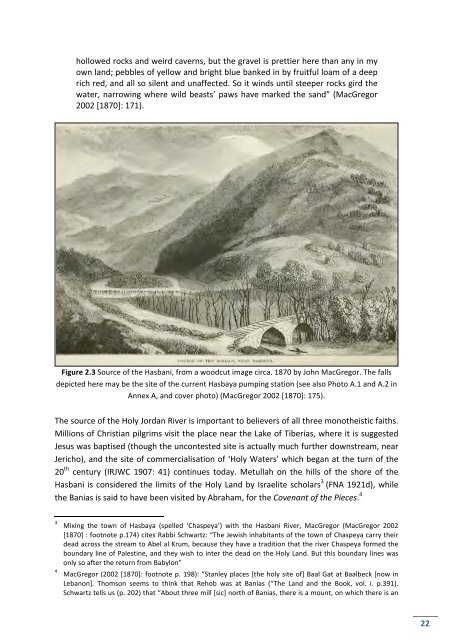Hydro-‐political Baseline of the Upper Jordan River - Ibrahim Abd El Al
Hydro-‐political Baseline of the Upper Jordan River - Ibrahim Abd El Al
Hydro-‐political Baseline of the Upper Jordan River - Ibrahim Abd El Al
You also want an ePaper? Increase the reach of your titles
YUMPU automatically turns print PDFs into web optimized ePapers that Google loves.
hollowed rocks and weird caverns, but <strong>the</strong> gravel is prettier here than any in my<br />
own land; pebbles <strong>of</strong> yellow and bright blue banked in by fruitful loam <strong>of</strong> a deep<br />
rich red, and all so silent and unaffected. So it winds until steeper rocks gird <strong>the</strong><br />
water, narrowing where wild beasts’ paws have marked <strong>the</strong> sand” (MacGregor<br />
2002 [1870]: 171).<br />
Figure 2.3 Source <strong>of</strong> <strong>the</strong> Hasbani, from a woodcut image circa. 1870 by John MacGregor. The falls<br />
depicted here may be <strong>the</strong> site <strong>of</strong> <strong>the</strong> current Hasbaya pumping station (see also Photo A.1 and A.2 in<br />
Annex A, and cover photo) (MacGregor 2002 [1870]: 175).<br />
The source <strong>of</strong> <strong>the</strong> Holy <strong>Jordan</strong> <strong>River</strong> is important to believers <strong>of</strong> all three mono<strong>the</strong>istic faiths.<br />
Millions <strong>of</strong> Christian pilgrims visit <strong>the</strong> place near <strong>the</strong> Lake <strong>of</strong> Tiberias, where it is suggested<br />
Jesus was baptised (though <strong>the</strong> uncontested site is actually much fur<strong>the</strong>r downstream, near<br />
Jericho), and <strong>the</strong> site <strong>of</strong> commercialisation <strong>of</strong> ‘Holy Waters’ which began at <strong>the</strong> turn <strong>of</strong> <strong>the</strong><br />
20 th century (IRJWC 1907: 41) continues today. Metullah on <strong>the</strong> hills <strong>of</strong> <strong>the</strong> shore <strong>of</strong> <strong>the</strong><br />
Hasbani is considered <strong>the</strong> limits <strong>of</strong> <strong>the</strong> Holy Land by Israelite scholars 3 (FNA 1921d), while<br />
<strong>the</strong> Banias is said to have been visited by Abraham, for <strong>the</strong> Covenant <strong>of</strong> <strong>the</strong> Pieces. 4<br />
3 Mixing <strong>the</strong> town <strong>of</strong> Hasbaya (spelled ‘Chaspeya’) with <strong>the</strong> Hasbani <strong>River</strong>, MacGregor (MacGregor 2002<br />
[1870] : footnote p.174) cites Rabbi Schwartz: “The Jewish inhabitants <strong>of</strong> <strong>the</strong> town <strong>of</strong> Chaspeya carry <strong>the</strong>ir<br />
dead across <strong>the</strong> stream to Abel al Krum, because <strong>the</strong>y have a tradition that <strong>the</strong> river Chaspeya formed <strong>the</strong><br />
boundary line <strong>of</strong> Palestine, and <strong>the</strong>y wish to inter <strong>the</strong> dead on <strong>the</strong> Holy Land. But this boundary lines was<br />
only so after <strong>the</strong> return from Babylon”<br />
4 MacGregor (2002 [1870]: footnote p. 198): “Stanley places [<strong>the</strong> holy site <strong>of</strong>] Baal Gat at Baalbeck [now in<br />
Lebanon]. Thomson seems to think that Rehob was at Banias (“The Land and <strong>the</strong> Book, vol. i. p.391).<br />
Schwartz tells us (p. 202) that “About three mill [sic] north <strong>of</strong> Banias, <strong>the</strong>re is a mount, on which <strong>the</strong>re is an<br />
22


